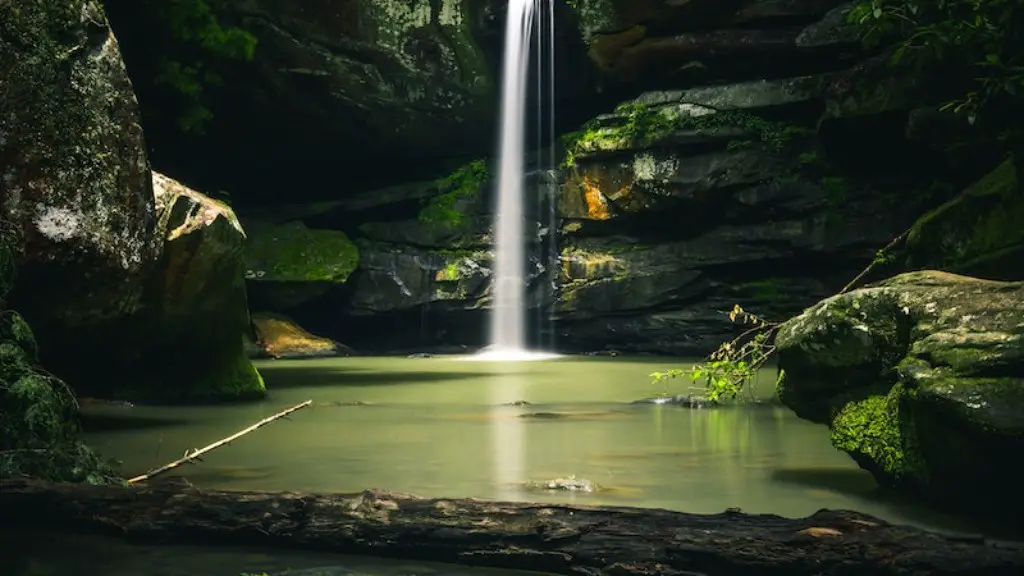Formation of the Mississippi River
The formation of the Mississippi River is an awe-inspiring feat in geology. This majestic body of water has shaped the history and culture of what is now known as the United States, and is an integral part of the natural diversity of North America. The river’s origin, however, is concentrated in the central plains region of the US, and can be traced to the Appalachian Mountains, where glaciation and millions of years of sediment build-up has combined to form the majestic Mississippi River.
In order to understand the formation of the Mississippi River, it is important to integrate three important perspectives: the geological perspective, the hydrological perspective, and the environmental perspective. We will now take a brief look at each one.
Geological Perspective
From the geological perspective, the Mississippi River originated around 18,000 years ago, when glaciers started to retreat from the area. As the glaciers receded, melting ice sheets allowed water to accumulate in certain spots, forming what would later become the Mississippi River. Glaciation caused by the advance and retreat of these long-term ice sheets helped shape many of the surrounding ecosystems, forming what appear today to be unique landforms like bluff and terraces.
Rivers then continued to flow through these newly formed river valleys, eroding sediment and creating the eventual contours of the Mississippi River. Today, the Mississippi runs the second-longest course in the United States and is spread over 2,320 miles, stretching from its source in Minnesota to its outlet in Louisiana.
Hydrological Perspective
From the hydrological perspective, the Mississippi River is the fourth-largest river in the world, by discharge. The river drains 31 US states and two Canadian provinces, covering a total of nearly two million sq miles. Its watershed produces more than 20% of all water in the United States, with an average annual flow of 520 billion gallons per day. Its channels also contain more than 200 tributaries, which supplement its main flow with additional water.
In terms of animal populations, the Mississippi River supports more than 130 different species of fish, as well as large populations of birds, turtles, and amphibians. The river also nourishes the surrounding lands, providing water for the growth of crops and vegetation.
Environmental Perspective
From the environmental perspective, the Mississippi River is one of the most ecologically diverse regions in the United States. The river is also a source of vital resources for humans, providing transportation, drinking water, food, energy, and recreation opportunities.
Unfortunately, the river has been significantly affected by human activities. Pollution, overfishing, and dredging have all taken a major toll on the Mississippi River’s aquatic ecosystem, resulting in reduced biodiversity and decreased water quality over time.
The implications of these changes are far-reaching, and the risk of further damage is an urgent concern, both for the environment and for human development. Fortunately, a number of initiatives are now underway to protect the Mississippi River and its resources, aimed at promoting a safe, healthy, and sustainable river system.
Economic Impact of the Mississippi River
The Mississippi River has long been a major economic resource for the nation, providing employment opportunities and contributing to national income and GDP. Much of this economic activity is driven by shipping and trade, and it is estimated that more than $200 billion worth of goods are transported on the Mississippi River each year. This helps to support approximately 750,000 jobs, contributing to a strong and vibrant regional economy.
In addition, the Mississippi River is also an important source of energy. With several hydroelectric dams and reservoirs along the course of the river, the river is an essential source of clean, renewable energy for the region. The region’s energy needs are met with the help of the Mississippi River, without the need for fossil fuels, enabling numerous communities to benefit from reliable and affordable energy.
Finally, the Mississippi River also provides recreation opportunities, with numerous parks and campgrounds located along its banks, helping to draw millions of visitors every year. Over 270 species of fish can be found in the area, providing unique experiences and activities for both locals and tourists alike. The river also offers opportunities for swimming, boating, and bird-watching.
Impact of Modernisation on the Mississippi River
Modernisation has had a profound impact on the Mississippi River. In the past, the river was wide, slow-moving, and shallow in many areas, making transportation difficult. Over time, however, the use of dredging and channeling has changed the character of the river, allowing for faster and more efficient transport of goods and people. In particular, dredging and channeling has made the river much deeper in some sections.
The effects of this modernisation can be seen in the numerous large shipping barges that now ply their trade up and down the river. At the same time, however, this heightened commercial activity has come at a cost, with increased pollution and a decrease in the area’s wildlife.
In addition, more frequent floods now take place along the river, resulting in more frequent and severe flooding. In some areas, this increased downstream flooding has caused problems for local communities. As a result, a number of measures have been implemented over the years in order to address these issues.
These measures include the construction of levees and dams in order to regulate water levels, as well as the introduction of regulations to limit pollutants in the water. Although some of these measures have been successful, more is needed in order to ensure the continued protection of the Mississippi River.
Effects of Pollution on Mississippi River
Pollution has been a major issue for the Mississippi River for many years. The river receives pollutants from agricultural and industrial sources, resulting in diminished water quality and hazardous levels of chemicals in the water. These pollutants not only threaten the health of local ecosystems, but also the health of people living in the area.
The most common pollutants in the Mississippi River system are nitrogen, phosphorous, and sediment. Nitrogen and phosphorous are both plant nutrients, but in excess amounts they can cause algal blooms which reduce oxygen levels in the water and can have devastating consequences for aquatic life. Sediment, meanwhile, can fill in channels, making the river more shallow and affecting navigation.
In order to address these issues, a number of initiatives have been implemented over the years. The most widely used approach is to reduce runoff from agricultural and industrial activities, which helps to reduce the amount of pollutants in the water. Other measures include the implementation of regular monitoring programs, the promotion of best management practices, and the adoption of green infrastructure.
Habitats and Wildlife of the Mississippi River
The Mississippi River forms the perfect habitat for a variety of unique species of animals and plants. The river provides many of these species with food, shelter, and a migratory route. Some of the more common species found along the river include turtles, mussels, fish, and waterfowl.
In addition, the Mississippi River is home to a wide variety of birds, including the graceful great blue heron, the majestic bald eagle, and the colorful common loon. These famous birds not only provide bountiful sport and recreational activities, but they are also important indicators of the health and stability of the region’s environment and ecosystem.
Finally, the Mississippi River is also home to a wide variety of aquatic organisms. These organisms, such as the iconic paddlefish, help to provide not only food, but also oxygen to water bodies, and are therefore essential to the health and stability of the river.
Human Uses of the Mississippi River
The Mississippi River has been a source of human sustenance for thousands of years. Native American tribes used the river for transportation, fishing, and hunting, and the river was also integral to the development of the US.
Today, the Mississippi River provides several important benefits to local and regional communities. In addition to providing water for drinking and irrigation, the river serves as an important transportation route, connecting the region to the rest of the US. In fact, a number of cities and towns are located along the banks of the river, providing access to markets and other destinations.
In addition, the river also provides a number of recreational opportunities, such as fishing, boating, and camping. Furthermore, a number of tourist activities, such as riverboat cruises and historic markers, are popular along the Mississippi River.
The Future of the Mississippi River
The future of the Mississippi River is uncertain. The river has been polluted and overused for many years, and its health is still in critical condition. Rising sea levels, changes in climate, and increasing human activity have all contributed to the destabilization of the river’s ecosystems.
Fortunately, a number of initiatives have been developed to help protect the Mississippi River and its resources. These efforts include building wetlands to help store water, establishing buffer zones and wildlife refuges, and creating green infrastructure to clean and filter runoff. At the same time, organizations such as the Mississippi River Transmission Corporation are actively working to improve water quality along the course of the river.
It is clear that there is much work to be done in order to protect the Mississippi River and its natural environment. However, with the efforts of conservationists and the local community, there is hope that the river and its environment can be restored to its natural state.





